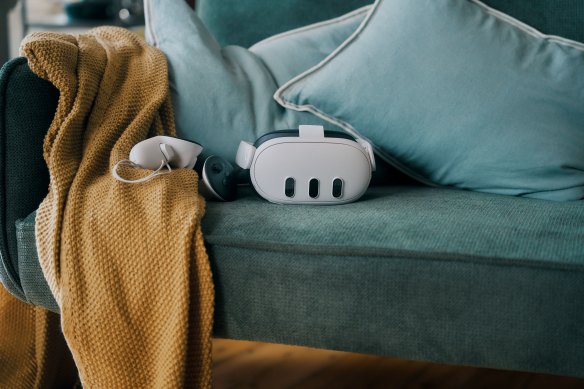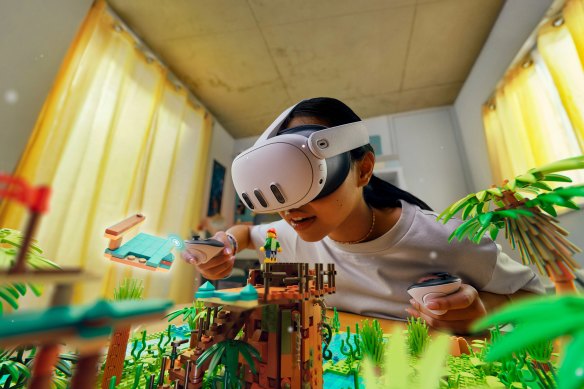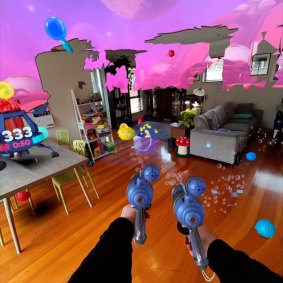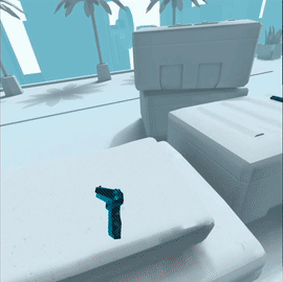
Save articles for later
Add articles to your saved list and come back to them any time.
Like its predecessor was when it released, the new Meta Quest 3 is easily the best virtual reality headset for most people. It’s light, easy to use, requires little setup and no extra hardware, and provides hours of cable-free VR gaming on a single charge. But unlike the Quest 2, this device also features colour pass-through letting you see the world around you blended with 3D graphics, which is promising for the future even if the software isn’t quite there yet.
VR headsets have a notoriously tough time winning over new users. They’re expensive, they can be uncomfortable, difficult to set up and calibrate, and invoke nausea or dizziness in a relatively short time. Addressing this is clearly the top priority for Meta; the Quest 3 may be lacking some high-end features VR enthusiasts will miss, such as motorised lenses or eye-tracking, but it’s among the comfiest and least expensive, starting at $800 with no PC or console required.
The Meta Quest 3 is much smaller than the Quest 2, and is also more comfortable to use.
The new system features pancake lenses, which are thinner, clearer and have a much broader sweet spot than the lenses on the Quest 2, as well as stunning 4K displays. Those who need to wear glasses in VR can easily do so, thanks to a built-in adjustable spacer.
It’s light enough that you can just whack it on and adjust the straps for a comfortable fit that doesn’t weigh on your face, though there is also the option of a “pro strap” with a rear brace that makes it more stable. The only annoying part of the initial fit is scrolling the wheel to set your pupillary distance, which you might need to measure with a ruler and a mirror if you don’t know it.
The Quest 3 can overlay digital images on our regular view of the world.
Another typical issue with VR is that once you have the headset on you’re cut off from the world around you, which is solved by the Quest 3’s pass-through cameras and brilliant tracking. You can tap the side of the headset at any time to pause your apps and see your surroundings, but you can also do certain things in mixed reality.
All the system menus for example can float in the space around you, as can virtual desktop apps or things like YouTube. You can interact with them by pointing or poking, and can even drag the windows around.
Being able to see your surroundings while using menus and certain apps helps a lot to keep VR sickness at bay.Credit: Tim Biggs
You can also play games entirely in mixed reality. Some simple games just overlay the graphics, so for example you can grab and twist virtual block puzzles while sitting at the table. But the more impressive ones require you to save your room’s layout by looking around at the walls, floor, roof and furniture, which becomes a wireframe games can use as the setting.
First Encounters is a game that comes with the headset, and though brief I can see it winning a lot of first-timers over. Fluffy aliens break into your house through the walls, and you need to chase them around and shoot them to round them up.
In First Encounters, pesky aliens bust through your walls and roof.Credit: Tim Biggs
Being able to see the room eliminates any VR sickness, meaning you can run and duck around the room as you play. Meta’s implementation of this technology is also the only one I’ve tried so far that presents distances accurately; other headsets such as HTC’s VIVE XR Elite made me dizzy because the angles and distances are off, but here I could walk around confidently. The tradeoff is that objects very close to you tend to warp, so while the resolution is good enough to check your phone mid-game, I wouldn’t want to sit down and read a book through the headset.
The main weakness for mixed reality right now is that few games and apps exist that use it well. Some tabletop board-game-style experiences let you play on your real-world table, there are a few variations on monsters coming through your walls, and some fitness and productivity apps project virtual displays, but the truly entertaining or useful applications are yet to arrive.
Pass-through aside, the Quest remains a very competent VR platform. It offers 10-times the resolution of Quest 2 and twice the processing power thanks to its new Snapdragon XR2 Gen 2 chip. Tracking latency is very low and the screen refresh is high (up to 120Hz), so I never felt a lag between my head movement and what was happening on screen. The included controllers are smaller and much improved, though many apps now also allow you to control using only your hands by pointing, pinching and gripping.
Our top five favourite Quest VR games
- Moss is a traditional 3D action platformer starring an adorable mouse, except you’re peering down into each environment as his invisible guardian angel. Has a recent sequel in Moss: Book II.
- Pistol Whip, like the also very popular Beat Saber, is an action game set to music. Shoot guns in time to the beat and whack your enemies if they get too close.
- Job Simulator is set in the distant future where robots attend a theme park to find out what human jobs were like, in a series of ridiculous tasks. Also has a great sequel Vacation Simulator.
- Walkabout Mini Golf is a simple but convincing putt-putt with new courses being added all the time. The best part is the ability to sync up with friends and have a chat while playing.
- Superhot is the closest you’ll get to feeling like you’re in the Matrix. It’s a series of shootouts where time moves as fast as you do, so you can slowly dodge between bullets between throwing ninja stars.
The Quest 3 works with everything released for the Quest 2, though some games are now receiving updates to support the new hardware’s extra power. Even if they don’t, I found games loaded faster and looked much clearer on the new headsets.
Messing around in Resident Evil 4.Credit: Tim Biggs
The kinds of things you can do in VR are entirely dependent on the developer’s imaginations, but outside of PC the Quest store has the widest selection of games you can get. Some do a really great job of making you feel like you’re inside the experience with interactive objects and physics, while others put a VR spin on more traditional game genres.
One of my favourite examples of this is the Quest version of the 2005 classic Resident Evil 4, where all your weapons and equipment are attached to different parts of your body, so you can physically grab them from their clip, holster or back strap. You also have to reload manually, and can throw your guns and knives around.
Those with a powerful computer can also use the Quest 3 as a PCVR headset, but it can be a little bit complicated. You’ll need a very long and high performance USB-C cable that can deliver enough power and bandwidth to the headset for the best results.
If you wire your PC to your router, and have your headset connect by 5GHz Wi-Fi at minimum, you can also try sending games wirelessly from your computer. But in my experience this adds noticeable (and potentially nauseating) latency.
Superhot, the shooter where time only moves when you do.Credit: Tim Biggs
One final point that needs addressing is that, although the hardware in this headset is incredible, some will be turned off purely because it’s from Meta. When the Quest 2 came out it had the caveat of requiring a Facebook account, which is something that comes with a lot of baggage. Meta has done a pretty good job of cleaning things up since then however; with Quest 3 you do not need to tie yourself to Facebook or Instagram, and the headset appears to do as much processing as possible on-device, which is good for privacy. Meta also says it does not collect data from the headset to target ads, and there are Apple-style health labels for each app showing the kinds of data they collect and how they use it. After a look through the privacy policy, the Quest 3 seems around on par with a smartphone in terms of your personal data being collected.
Meta has also invested heavily in its own software for Quest, including the Horizon Worlds social spaces where you can hang out as a virtual avatar of yourself and play games with friends, but like Roblox and other metaverses it mostly just made me feel old. Interacting with other people’s avatars with your hands and voice is becoming more seamless though, and the spaces now include everything from shooting games to open mic comedy clubs, so it’s possible Worlds will only become more popular.
Get news and reviews on technology, gadgets and gaming in our Technology newsletter every Friday. Sign up here.
Most Viewed in Technology
From our partners
Source: Read Full Article





